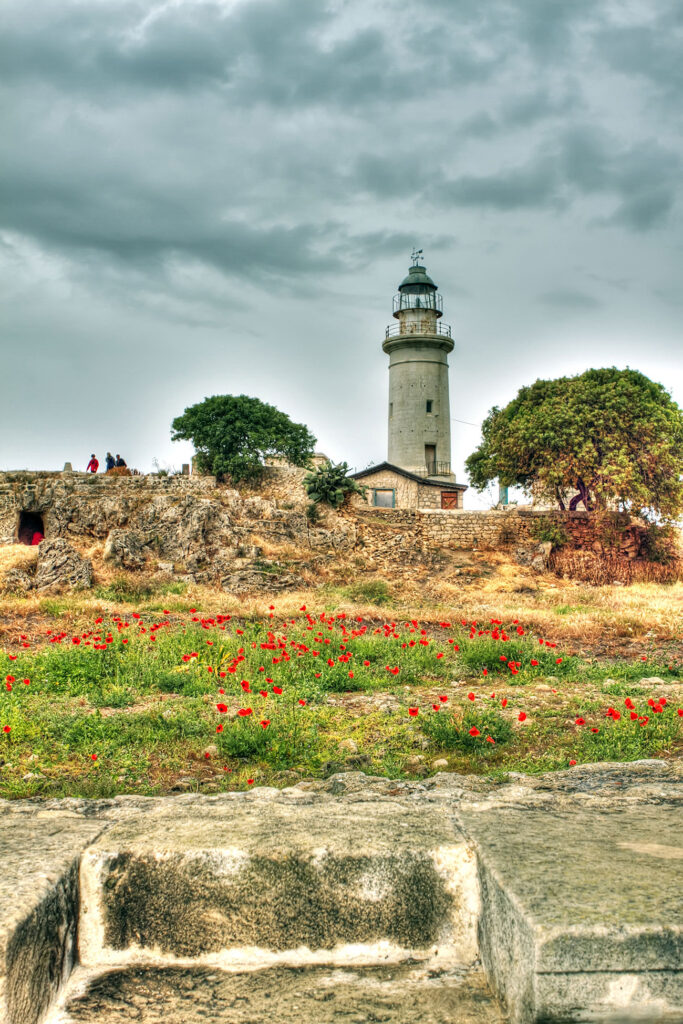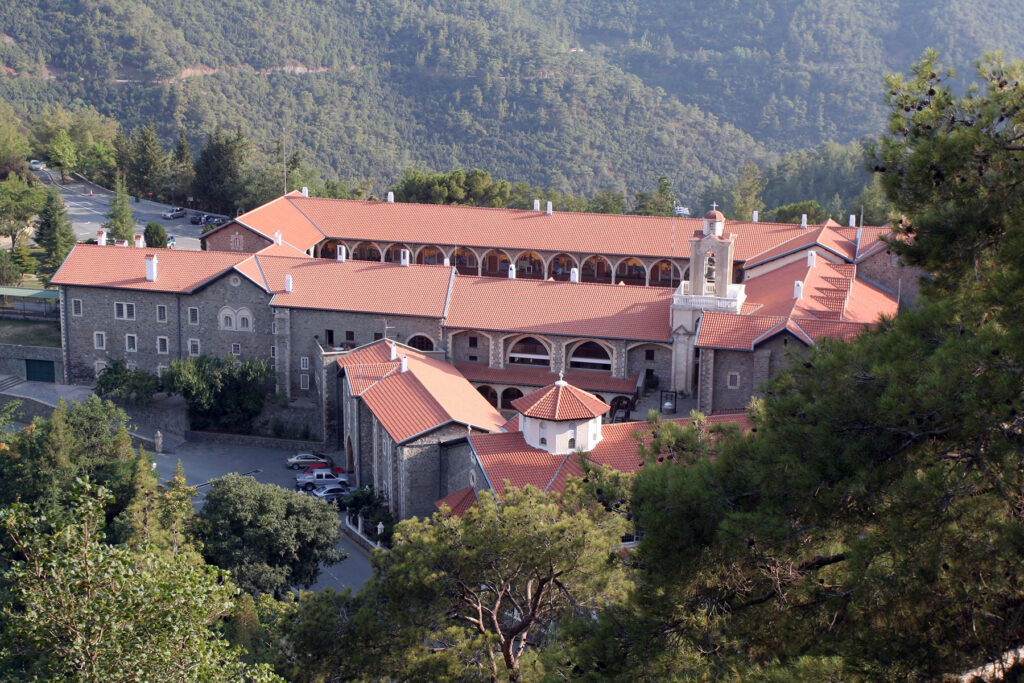Top 12 Cyprus Attractions
Cyprus, a jewel in the Eastern Mediterranean, offers a blend of stunning landscapes, rich history, and vibrant culture, making it a captivating destination for travelers. Here are the main attractions that embody the island’s diverse appeal:

1. Κourion Ancient Amphitheater
The Kourion Ancient Amphitheater is a spectacular archaeological site located near Limassol, Cyprus, part of the extensive ruins of the ancient city-kingdom of Kourion. Dating back to the 2nd century AD, this Greco-Roman theater has been remarkably preserved and restored, showcasing the architectural brilliance of the era. Perched on a hillside with stunning views of the surrounding countryside and the Mediterranean Sea, the theater once accommodated up to 3,500 spectators. It served as a venue for gladiatorial games and theatrical performances in antiquity and continues to host cultural events and performances today, bringing ancient traditions to life. The Kourion Amphitheater is a testament to Cyprus’s rich history and its enduring legacy as a center of culture and civilization in the Mediterranean.

2. Archaeological Site of Nea Paphos
The Archaeological Site of Nea Paphos, located on the southwest coast of Cyprus, is a UNESCO World Heritage site of immense historical significance. Founded in the late 4th century BC, Nea Paphos served as the capital of Cyprus during the Hellenistic and Roman periods. This ancient city is famed for its remarkable mosaics in the Houses of Dionysos, Theseus, Aion, and Orpheus, which are among the finest in the Mediterranean, showcasing intricate designs that depict various scenes from Greek mythology. The site encompasses a vast area featuring well-preserved ruins, including public buildings, private houses, a theatre, and a necropolis known as the Tombs of the Kings. Visitors to Nea Paphos can explore the remnants of this ancient civilization, offering a glimpse into the past where politics, culture, and religion intertwined. The archaeological treasures of Nea Paphos provide a fascinating insight into ancient life and art, making it an essential destination for history enthusiasts and travelers alike.

3. Kykkos Monastery
Kykkos Monastery, nestled in the Troodos Mountains of Cyprus, is among the island’s most famous and wealthiest monastic institutions. Founded in the 11th century, it is dedicated to the Virgin Mary and is renowned for housing one of three icons attributed to the Apostle Luke. The monastery’s lavish decorations, including gold-plated icons and exquisite mosaics, reflect its historical significance and wealth. Despite its remote location, Kykkos Monastery attracts thousands of visitors and pilgrims annually, drawn by its spiritual significance, stunning architecture, and the breathtaking natural beauty of its mountain setting. The monastery also features a museum with religious relics, icons, and other artifacts, offering insights into the Orthodox Christian faith and Cypriot history. Its peaceful surroundings and rich heritage make Kykkos Monastery a must-visit for those seeking spiritual solace and an understanding of Cyprus’s religious traditions.

4. Salamis Forest
Situated near the ancient city of Salamis in the northern region of Cyprus, is a serene and verdant area that offers a tranquil escape into nature. This expansive forest encompasses a variety of flora and fauna, providing a refreshing contrast to the nearby archaeological ruins. The forest’s trails invite visitors to explore its natural beauty on foot, offering peaceful walks under the canopy of pine and eucalyptus trees. The area is also popular for picnics, bird watching, and simply enjoying the quietude away from the hustle and bustle of city life. Salamis Forest serves not only as a green oasis but also as a historical backdrop, with the ancient ruins of Salamis nearby, making it a unique destination where history and nature intertwine. Whether you’re an avid hiker, a nature lover, or someone looking to delve into the historical ambiance of Cyprus, Salamis Forest offers a captivating experience.

5. Archaeological Site of the Tombs of the Kings
The Archaeological Site of the Tombs of the Kings is a prominent historical landmark located near Paphos, on the western coast of Cyprus. Despite its name, the site was the final resting place for high-ranking officials and aristocrats rather than royalty. Dating back to the 4th century BC, this necropolis is part of the Paphos UNESCO World Heritage site and is famous for its impressive underground tombs, which were carved out of solid rock and are notable for their Doric columns and frescoed walls, echoing the grandeur of the period.
The Tombs of the Kings spreads over a vast area, with tombs varying in complexity, some featuring open courtyards and others adorned with intricate carvings, demonstrating a blend of Egyptian, Greek, and Roman architectural influences. The site offers visitors a unique journey into the ancient past, providing insights into the burial customs and beliefs of the time. Its historical significance, combined with the architectural beauty and serene atmosphere, makes the Tombs of the Kings a fascinating destination for both history buffs and casual tourists.

6. Holy Church of Saint Lazarus
The Holy Church of Saint Lazarus is a remarkable and revered monument located in the heart of Larnaca, Cyprus. This magnificent 9th-century church is dedicated to Saint Lazarus of Bethany, the subject of a miraculous resurrection by Jesus Christ as recounted in the New Testament. According to Orthodox Christian tradition, after his resurrection, Lazarus lived in Cyprus and became the first Bishop of Kition (present-day Larnaca), where he died and was buried for the second time.
The church is an exquisite example of Byzantine architecture, featuring distinctive stone construction, an ornate interior with precious icons, and a gold-covered iconostasis. Beneath the sanctuary lies the tomb of Saint Lazarus, making it a significant pilgrimage site. Every year, the church attracts thousands of visitors and faithful who come to venerate the saint and admire the church’s architectural beauty and historical significance. The Holy Church of Saint Lazarus stands not only as a place of worship but also as a testament to Cyprus’s rich religious heritage and history.

7. Landmark of Hala Sultan Tekkesi & Salt Lake
The Hala Sultan Tekke is a revered Islamic shrine located near Larnaca, on the southern coast of Cyprus. Situated on the west bank of the Salt Lake, it is one of the most significant Islamic pilgrimage sites, ranking after Mecca, Medina, and Al Aqsa Mosque in Jerusalem in importance. This mosque and mausoleum complex is dedicated to Umm Haram, a close relative of the Prophet Muhammad, who died on this site during the first Arab raids on Cyprus in the 7th century. The serene and picturesque setting of Hala Sultan Tekke, combined with its historical and spiritual significance, makes it a unique and compelling attraction.
Adjacent to the mosque is the Larnaca Salt Lake, a natural wonder that transforms into a habitat for flocks of flamingos and other migratory birds during the winter months. In the summer, the lake dries up, leaving behind a crust of salt on the surface. This stunning contrast between the spiritual tranquility of the Tekke and the natural beauty of the Salt Lake creates a captivating landscape that draws visitors from around the world.

8. Bellapais Abbey
Bellapais Abbey, or “Abbey of Peace,” is a stunning example of Gothic architecture, perched majestically on the mountainside overlooking the town of Kyrenia, in the northern part of Cyprus. Dating back to the 13th century, this historical masterpiece was built by the Augustinian monks, and its remnants tell a tale of Cyprus’s rich medieval history. The Abbey is renowned for its impressive facade, beautiful cloisters, and the exquisite views it offers of the northern coast and the Mediterranean Sea. The site also hosts concerts and cultural events, utilizing its remarkable acoustics and atmospheric setting. Visiting Bellapais Abbey not only allows one to step back in time but also to experience the tranquil beauty that has inspired artists and writers, including Lawrence Durrell in his book “Bitter Lemons.

9. Kolossi Castle
Kolossi Castle is a striking example of military architecture, located near Limassol, Cyprus. This well-preserved fortress dates back to the 13th century, originally built by the Knights of St. John of Jerusalem, and later occupied by the Knights Templar. The castle played a significant role in the Crusades and was a key center for the production of Commandaria, one of the oldest named wines in the world, still produced in the region. Kolossi Castle stands as a three-story rectangular keep with an attached sugar mill, showcasing the strategic importance and wealth of its medieval occupants. Visitors can explore the interior chambers, climb to the battlements for panoramic views of the surrounding vineyards and countryside, and delve into the rich history of the Crusader knights in Cyprus. Its historical significance, coupled with its architectural beauty, makes Kolossi Castle a fascinating destination for history enthusiasts and visitors alike.

10. Stavrovouni Monastery
Stavrovouni Monastery, perched atop a mountain in Cyprus, is one of the oldest and most revered monastic sites on the island. Founded in the 4th century by Saint Helena, mother of Emperor Constantine the Great, the monastery is said to house a piece of the Holy Cross. Due to its elevated location, it offers breathtaking panoramic views of the surrounding countryside and the Mediterranean Sea. The monastery strictly adheres to Orthodox traditions and, as such, has a policy that only allows male visitors. Despite this restriction, the spiritual significance and historical depth of Stavrovouni make it a beacon for pilgrims and those interested in the rich religious heritage of Cyprus. Its austere beauty, coupled with the serene atmosphere and significant religious artifacts, provides a unique and profound experience for visitors.

11. Petra tou Romiou (Aphrodite’s Rock)
Petra tou Romiou, also known as Aphrodite’s Rock, is a stunning natural landmark located on the southwestern coast of Cyprus, near Paphos. According to mythology, this striking sea stack is the birthplace of Aphrodite, the Greek goddess of love and beauty, who is said to have emerged from the foam of the waves. The site offers breathtaking views of the Mediterranean Sea, making it a popular spot for photography, especially at sunset when the scenery is particularly captivating.
The area surrounding Petra tou Romiou is steeped in legend and beauty, with pebbled beaches and crystal-clear waters inviting visitors to take a dip, though swimming near the rock can be challenging due to the strong currents. Despite this, many are drawn to the site, hoping to touch the rock and gain the blessings of eternal beauty that legend promises. Whether you’re a lover of mythology, a seeker of natural wonders, or simply in search of picturesque landscapes, Petra tou Romiou is a must-visit destination that encapsulates the enchantment of Cyprus.

12. Pano Lefkara
Pano Lefkara is a picturesque village nestled in the southern foothills of the Troodos Mountains in Cyprus, renowned for its traditional lace, known as Lefkaritika, and exquisite silver handicrafts. This charming village, with its cobbled streets and stone-built houses, offers a glimpse into Cyprus’s rich cultural heritage. Lefkaritika lace, which gained fame when it reportedly caught the eye of Leonardo da Vinci during a visit, is characterized by intricate designs and has been listed as an Intangible Cultural Heritage by UNESCO. Visitors to Pano Lefkara can explore the narrow lanes, visit local artisans to see them at work creating lace and silver items, and enjoy the serene atmosphere that has inspired artists and writers for centuries. The village also boasts beautiful examples of traditional Cypriot architecture, making it a must-visit for those looking to experience the authentic charm of Cyprus.
Cyprus combines natural beauty, ancient ruins, and lively cultural scenes, making it a compelling destination that caters to all types of travelers. Whether you’re exploring its historic sites, enjoying the beaches, or wandering through its mountain trails, Cyprus offers a unique blend of experiences that linger in the memory long after the visit.
